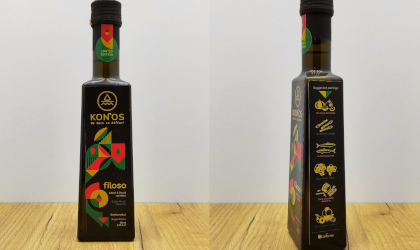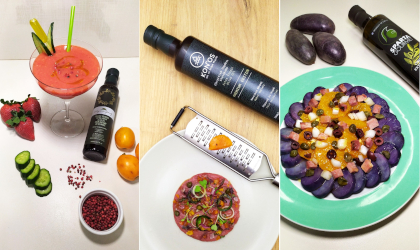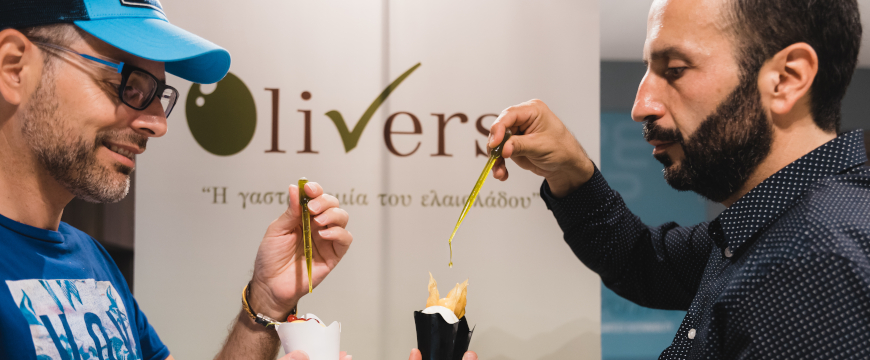What should I do with this olive oil? Four years ago, two Greek olive oil professionals decided to focus on answering that question. Kostas Tsoronis and Panagiotis Papanikolopoulos created Oliverse and started leading seminars in Greece and online to explore olive oil – food pairings: the way specific extra virgin olive oils combine with particular foods.
Papanikolopoulos admits that he used to think “Kalamata olive oil was the best. Nowadays if you ask me which is the best olive oil, I’ll ask you which food you want to use it with, and I’ll tell you.” Typically Greek in his attachment to the olive oil of his native region, as he told Greek Liquid Gold, Papanikolopoulos was eventually convinced that in spite of acquired tastes, exploration can open most minds and palates to intriguing new possibilities.
After returning to Greece from an intensive university course on olive oil assessment in Spain, Tsoronis convinced his old high school friend to seriously consider a broad array of olive oils. Now the two agree that the question of the best olive oil for a certain food requires a very specific answer, one based on a group taste test they have perfected with their trained team of evaluators.
The Oliverse duo won’t say, for example, that all Koroneiki variety olive oil pairs well with fish, because such a vague claim may be misleading. Even extra virgin olive oils (EVOOs) made from the same olive variety reveal significant differences. As Oliverse told Greek Liquid Gold, “each EVOO has its own sensory profile. The profile depends on the olive variety, the olive ripening degree, the microclimate of the region (terroir), and many other factors related to the processes of harvesting, milling, olive oil storage, and packaging.”
When they started their endeavor in olive oil – food pairings, Tsoronis and Papanikolopoulos said, they were planning “to explore and apply the theory behind the book Manual de cata y maridaje del aceite de oliva (Manual of olive oil tasting and pairing) by Marino Uceda, M. Paz Aguilera, and Isabel Mazzucchelli, which is the most specialized book on olive oil pairing.” The book focuses on flavor intensity (fruitiness, bitterness, and pungency). According to its theory, as the Oliverse duo explains it, EVOOs are classified as belonging to one of several categories:
• Delicate Fruity
• Mild Sweet Fruity
• Medium Delicate Fruity
• Medium Bitter Fruity
• Complex Harmonious Fruity
• Complex Bitter Fruity
Oliverse reports that they “also analyze the tasting notes of each olive oil” (such as herbs, tomato leaves, floral aromas, or green apple) with their own “team of professionals from various disciplines.” Over four years, they have developed “a large and valuable ‘database’” of olive oil – food pairings.
But, we may ask, isn’t the question of food pairings a matter of taste? And isn’t taste a very subjective matter? Yes, they admit, but the Oliverse duo has found that a majority tends to agree on pairing suggestions. They explain:
“There are three distinct options to pair EVOOS with food:
• Similar flavors
• Complementary flavors
• Contrasting flavors
The aim is to familiarize consumers with that philosophy. In addition to that, as we teach in our seminars, olive oil is an exceptional condiment and therefore unarguably is a matter of personal taste.”
Consumers can decide which of the three schemes they want to use at any given time. To help them and others explore possibilities, the Oliverse duo has organized dozens of thematic olive oil – food pairing seminars that have been “focused on distinct olive varieties or on certain olive-producing areas of Greece.”

Moreover, in each of their Instagram Live episodes, they have featured a specific extra virgin olive oil, analyzing its sensory profile and preparing two recipes tailor-made for its unique characteristics. Oliverse has also compiled olive oil lists for prestigious Greek restaurants. Several olive oil producers have even incorporated food pairings suggested by Oliverse on their company websites or—in a noticeably innovative move—on their bottle labels.
A wide range of excellent Greek extra virgin olive oils is now available in many parts of the world, but for consumers who cannot find the specific olive oils recommended for a particular food pairing, Oliverse recommends the “trial-and-error” method. They suggest that everyone have three or four different high-quality monovarietal EVOOs in their kitchen and perform their own food pairing experiments to see what appeals to them.
Some examples of Oliverse’s recommendations for olive oil – food pairings
Sparta Gourmet Organic (Koroneiki variety), classified as “Medium Delicate” with tasting notes of herbs, green grass, tomato leaves, and green walnut
Food pairings: grilled pork chops, grilled vegetables, lentil soup, boiled potatoes
Kontogiannis Family Organic (Manaki variety), classified as “Mild Sweet” with tasting notes of tomato, bitter greens, herbs, and walnut
Food pairings: roast chicken, pumpkin soup, grilled white fish, chickpea stew
Konos Premium Edition (Makris variety), classified as “Medium Bitter” with tasting notes of floral aromas, green apple, green almond, and forest fruits (berries)
Food pairings: braised beef, curry risotto, spicy tomato soup, vegetable salads
A few simple recipes made with specific olive oils
Maniatiki Potato Salad
Ingredients
Boiled potatoes, sliced (we used purple Peruvian ones)
Peeled segments of sweet oranges
Cured pork meat, cut in small cubes
Slices of Kalamata olives
Capers
Diced onions
Sparta Gourmet Organic Koroneiki variety EVOO
Salt and pepper to taste
Directions
Mix all the ingredients in a bowl, season, and drizzle with the EVOO.

Spring Fruit Smoothie
Ingredients
Strawberries
Loquats, peeled and pitted
Cucumber, peeled
Pink peppercorns
Kontogiannis Family Organic Manaki variety EVOO
Directions
Blend all the fruit until smooth.
Drizzle with the EVOO.
Season with a few pink peppercorns.
Carpaccio
Ingredients
Grass-fed beef tenderloin, in very thin slices (always kept well chilled, since it is served raw)
Capers
Jalapeno pepper, sliced
Aji Amarillo (Peruvian yellow chili pepper), finely diced
Sping onions, sliced
Sprouts
Grated cured egg yolks
Fleur de sel
Konos Premium Edition Makris variety EVOO
Directions
Place the thin slices of beef tenderloin on a plate.
Decorate with all the other ingredients.
Drizzle with the EVOO.
Also known as the Gastronaftis (a play on the Greek words for gastronomy and astronaut), Panagiotis Papanikolopoulos is a food writer and restaurant critic for well-known Greek publications. He is also a certified olive oil taster for the University of Peloponnese in Kalamata (one of just three Greek olive oil tasting panels accredited by the International Olive Council [IOC]), an olive oil competition judge, and a panel leader at the London International Olive Oil Competitions.
Another member of the same tasting panel as well as a competition judge, Kostas Tsoronis is a chemist focused on olive oil technology and food safety. He has educated students and served as a consultant for olive oil producers regarding all stages of production and evaluation, as well as working as a quality manager for olive mills and bottling companies. With a Master’s degree in food safety and quality management, he also completed the Italian National Organization of Olive Oil Tasters’ olive oil sensory analysis course, the IOC’s course for panel leaders, and the IOC’s university-level course on the Organoleptic Assessment of Olive Oil at the University of Jaén, Spain.
All businesses, organizations, and competitions involved with Greek olive oil, the Mediterranean diet, and/or agrotourism or food tourism in Greece, as well as others interested in supporting Greeks working in these sectors, are invited to consider the advertising and sponsorship opportunities on the Greek Liquid Gold: Authentic Extra Virgin Olive Oil website. The only wide-ranging English-language site focused on news and information from the Greek olive oil world, it has helped companies reach consumers in more than 215 countries around the globe.


